
The Story of the American Expeditionary Forces
|
28th Division
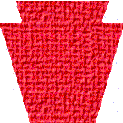
|
SECOND BATTLE
OF THE
MARNE
|

The 'Men of Iron' of the 28th Division at the Marne

| Quick Facts | Background |
| Phase I | Phase II | Phase III |
Quick Facts
-
 Where: The Aisne-Marne Sector, 75 Miles Northeast of Paris
Where: The Aisne-Marne Sector, 75 Miles Northeast of Paris
In a Triangular Area Bounded by Chateau-Thierry, Soissons and Reims
Check the Location on a Map of the Western Front
-
 When: July 15 - September 16, 1918
When: July 15 - September 16, 1918
-
 AEF Units Participating: Nine U.S. Divisions Under French Command, Coordinated by Marshal Ferdinand Foch
AEF Units Participating: Nine U.S. Divisions Under French Command, Coordinated by Marshal Ferdinand Foch
Click Here To See a List of U.S. Divisions and Their Commanders
-
 Opposing Forces: German First, Third, Seventh and Ninth Armies
Opposing Forces: German First, Third, Seventh and Ninth Armies
 Memorable For: Starting with the Last German Offensive of the Great War and Becoming the Allies' First Victorious Offensive of 1918
Memorable For: Starting with the Last German Offensive of the Great War and Becoming the Allies' First Victorious Offensive of 1918
The Second Battle of the Marne marked the turning of the tide in World War I. It began with the last German offensive of the conflict and was quickly followed by the first allied offensive victory of 1918. The American Expeditionary Force with over 250,000 men fighting under overall French command played key roles both in the initial defense and the later advances. In the Second Battle of Marne with 30,000 killed and wounded, the United States started suffering casualties on the enormous scale usually associated with the battles of the Great War.
|
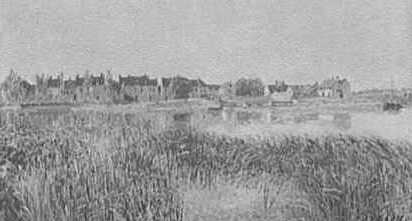
The River Marne, 1918
|
In late May, the German high command had ordered a major offensive from the Chemin des Dames northeast of Paris towards the River Marne threatening both Paris and the Paris - Verdun rail link. The 2nd and 3rd divisions of the AEF helped defend along the Marne on either side of the river town of Chateau Thierry. What resulted was a rounded bulge in western front thirty miles wide at the base, extending south about 25 miles to its apex right at Chateau Thierry. With American encouragement, a plan evolved to eliminate this salient with a two pronged assault from the west and south.
In July, when it became clear that the Germans would renew their assault in the area, a decision was made to absorb the assault, let the enemy tire themselves, and then counterattack soon afterwards.
There were three distinct parts to the battle of the Marne and they will be discussed separately in this article. Since this piece was produced for the Doughboy Center, the emphasis will be on the American participation. French, British and Italian forces fought hard and in great numbers in this huge operation as well. Here is a summary of those three phases with some key dates:
Phase I: THE 5TH LUDENDORFF OFFENSIVE,
July 15-17, 1918
-
July 15
-
Three and one-half German Armies attack in the early morning.
The 3rd Division of AEF makes a strategically important stand on the left end of the Marne River line.
-
July 17
-
-
German units occupy southern bank of Marne between Epernay
and Chateau Thierry and advance their line 7 miles east of Reims.
|

Watching the Americans Dig In
|
Phase II: THE AISNE-MARNE COUNTER OFFENSIVE,
July 18 - August 17, 1918
-
-
July 18
-
French 10th and 6th Armies attack the salient from the west Tanks are used effectively and four American divisions lead a rapid advance. German high command decides to reinforce the salient to avoid a rout.
-
July 19
-
American units south of Soissons start meeting fanatical
resistance. German air force commands the air.
-
July 21
-
Second assault against the salient from the south. Five
more AEF divisions would eventually be committed.
-
July 30-Aug 1
-
Battle before Sergy; Ourcq River line crossed.
-
Aug 4-22
-
Tenacious battle before Vesle River at Fismes and
Fismette as German Army defends vigorously on the
Vesle.
Phase III: THE OISE-AISNE OFFENSIVE,
AUGUST 18 - SEPTEMBER 16, 1918
-
Aug 18
- French 10th Army launches major offensive near Soissons
-
Aug 28-Sep 2
- US 32nd Division captures key town of Juvigny cutting the Soissons-St. Quentin road. Germans find Vesle line untenable and withdraw before River Aisne.
-
Sep 4
- Vesle River crossed; US 28th & 77th Divisions advance.
-
Sep 16
- Last full American division in sector [77th] relieved as the axis of the French and American offensive operations shifts east to the Champagne and Verdun sectors.
|
The 5th Ludendorff Offensive, July 15-17, 1918

Ludendorff, Himself
Click Here To See a Map of the Battle's First Phase
At midnight, July 14/15 the artillery crashed and the last German push of the war started. As predicted, it was a drive to get across the Marne [east of] Chateau-Thierry...[From Chateau-Thierry east were] the Third American Division...where they'd been ever since their machine gunners had come charging up the riverbank six weeks before. Then came another French outfit and next the pea-green Pennsylvania National Guard -- The 28th Division -- which had no line time even in a quiet sector. They were fed in by companies to fight with the French. Farther east {of Reims] there was the veteran 42nd Division, the Rainbow...That night and the next day the 38th Infantry Regiment of the 3rd Division, made a stand that deserves to rank with the famous ones, and it won.
|

Men of the 42nd Division Prior to the Marne
Several of these men were killed by artillery fire just 5 minutes after the photo.
|
The 38th was in line just west of where the Surmelin River flows north into the Marne. The Surmelin runs northwest and down either side of its gentle valley there ran two good roads which went south into the main Paris highway. This was to be the main German track, the route by which guns were to move south and help exploit a breakthrough.
[Westpointer, Colonel Ulysses Grant McAlexander commanded the 38th.] Down by the [Marne] river he put Major Guy Row's 2nd Battalion. The 1st Battalion, only half strength, was farther back in the support, and the 3rd Battalion even deeper in reserve.
Along the river Row's men had three companies in line...from left to right -- each with two platoons dug in down on the riverbank, two more about three hundred and fifty yards back behind the embankment of the east-west Metz-Paris railroad. The railroad was raised up on a constructed embankment about nine feet high and so wide it was very difficult to fight from behind it.
|
|
The story continues with a firsthand description of the defense along the River Marne by Captain Jesse Woolridge of Major Rowe's battalion:
...Newly captured prisoners began to give real information - a grand offensive was to be made [where] the Marne was only about 50 yards wide...We had 600 yards of [this] front all to ourselves...[When it began] it seemed [the Germans] expected their artillery to eliminate all resistance...French Officers attached to our Brigade stated positively there was never a bombardment to equal it at Verdun.
At 3:30am the general fire ceased and their creeping barrage started - behind which at 40 yards only, mind you, they came - with more machine guns than I thought the German Army owned...
The enemy had to battle their way through the first platoon on the river bank - then they took on the second platoon on the forward edge of the railway where we had a thousand times the best of it - but the [Germans] gradually wiped it out. My third platoon [took] their place in desperate hand to hand fighting, in which some got through only to be picked up by the fourth platoon which was deployed simultaneously with the third...By the time they struck the fourth platoon they were all in and easy prey.
It's God's truth that one Company of American soldiers beat and routed a full regiment of picked shock troops of the German Army...At ten o'clock...the Germans were carrying back wounded and dead [from] the river bank and we in our exhaustion let them do it - they carried back all but six hundred which we counted later and fifty-two machine guns...We had started with 251 men and 5 lieutenants...I had left 51 men and 2 second lieutenants...
Capt. Jesse Woolridge, 38th Inf., 3rd Division
|
|
The German Commander quoted:
...All [German] divisions [along the Marne] achieved brilliant successes, with the exception of the one division on our right wing. This encountered American units! Here only did the Seventh Army, In the course of the first day of the offensive, confront serious difficulties. It met with the unexpectedly stubborn and active resistance of fresh American troops.
While the rest of the divisions of the Seventh Army succeeded in gaining ground and gaining tremendous booty, it proved impossible for us to move the right apex of our line, to the south of the Marne, into a position advantageous for the development of the ensuing fight. The check we thus received was one result of the stupendous fighting between our 10th Division of infantry and American troops...
Erich von Ludendorff, Quartermaster General
|
The Aisne-Marne Counter Offensive
July 18 - August 17 1918

1st Division Troops on the Attack
|
In the first days of July, 1918, it became apparent that the Germans would be unable to launch more than one other great attack, and towards the 10th of the month it was believed certain that if the enemy attacked the blow would fall in Champagne. Thanks to the arrival of American troops, the Allied reserves were now sufficiently numerous to justify a counterattack, and if, as every High Command was confident, the Champagne front could hold with the troops already allotted to it, the Allied Command retained complete freedom in the selection of the front upon which the counterattack should fall. The selection by the Germans of Champagne and the eastern face of the Marne salient, as the fronts on which they were to make their last effort was fortunate for the Allies; for this decision of the enemy allowed an Allied counterattack which, while affording immediate relief to the enemy's thrust, would also obtain other advantages for the Allied cause.
Click Here To See a Map of the Battle's Second Phase
|

Jumping Off
Paris is still France, and the approach of the German lines along the Marne toward Paris had caused apprehension throughout France; it was essential that the threat on Paris be relieved at the earliest possible moment. Aside from reasons of morale, purely material reasons also demanded the reduction of the Marne salient as the first task of the Allies when the offensive should pass to their hands. Paris contained a multitude of essential war industries, and so long as the Germans maintained their lines these industries were seriously hampered by the constant long range bombardments and air raids. The great east and west railroad through Chateau-Thierry must also be regained by the Allies as a first necessity in the troop movements required in any general offensive.
|

German Ammo Train in Marne Salient
|
But while with each day there came increased certainty that the Allied counterattack could be properly launched to the north of Chateau-Thierry, and while the French armies on that front began to plan accordingly, the Allied resources were not sufficiently great to permit a final decision until after the actual launching of the hostile attack; it thus happened that only on the 16th could many of the actual preparations be commenced.
The general plan for the Allied counterattack of July 18th involved attacking the entire west face of the Marne salient. This main attack was first to pivot on Chateau-Thierry; later the Allies in the region of Chateau-Thierry were to take up the attack. The Allies were also to attack that part of the German salient south of the Marne and to the southwest of Reims. The plan then really involved attacking the entire Marne salient, the principal blow falling at first on the west face, with the critical point, at which eventual success or failure would be determined, southwest of Soissons. The three divisions selected to break the most sensitive part of the German line were the 2nd American, the 1st Moroccan (French) and the 1st American. If these three divisions could seize and hold the heights south of Soissons the German position in the salient proper became untenable and it's ultimate reduction was assured.
|

At the Receiving End of Allied Artillery
|
At 4:35a.m., July 18th, after some of the American infantry had double-timed into line and when some of their guns had barely gotten into position, the 1st and 2nd American Divisions and the 1st Moroccan Division jumped off. Notwithstanding their desperate resistance the Germans were driven back and the results upon which ultimate success depended were secured.
The 2nd Division advanced 8 kilometers in the first 26 hours, took about 3,000 prisoners, 2 batteries of 150mm guns, 66 light guns and 15,000 rounds of 77 mm ammunition, besides much other property. This Division suffered some 4,000 casualties and, as it had made exhausting marches to reach the battlefield, and having recently been withdrawn from it's desperate fighting at Chateau-Thierry, the Division was relieved after the second day.
|
Key American Commanders at Soissons
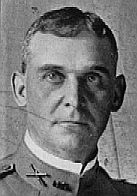
Maj. Gen. Charles Summerall
Commander,
1st Division
|
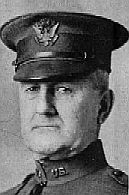
Maj. Gen. James Harbord
Commander,
2nd Division
|
|
The 1st Division suffered 7,000 casualties, of whom it is believed that not one was a prisoner. Sixty per cent of it's infantry officers were killed or wounded, in the 16th and 18th Infantry all field officers were casualties except the colonels, were casualties. Notwithstanding it's losses, the 1st Division, by constant attacks throughout four days and nights, had broken through the entrenchment's in the German pivot to a depth of 11 kilometers, had captured 68 field guns and quantities of other material, in addition to 3,500 prisoners taken from the seven separate German divisions which had been thrown against the 1st United States Division in the enemy's desperate effort to hold ground which was essential to his retaining the Marne salient.
Never again could friend or enemy question the fighting qualities of the American soldier!
But while the work of the 1st and 2nd Divisions attracted most attention because of the special importance of their attack, they were not the only American divisions to participate in the July 18th offensive. [A little south of the 2nd Division, units 4th Division had been separated and were in line with French divisions. They joined in the attack and continued to advance until July 22nd. The 4th Division was subsequently re-assembled as a division and would relieve the 42nd Division in the salient on August 2nd.] The 26th Division was just northwest of Chateau-Thierry and together with the 167th French Division formed the 1st American Corps, which was the first American corps to exercise tactical command. This corps acted as a pivot in the beginning and later had to advance under peculiarly difficult conditions. For the 26th Division maneuver was much complicated in order that the front of the division might conform to the general plan; not only was it necessary for the division to pivot during attack, but at one time, the right half of the division had to attack simultaneously in two directions.
|

Memorial to Lt. Quentin Roosevelt, Son of Theodore Roosevelt
KIA Flying in Support of the Aisne-Marne AssaultNote the terrain, 10miles N. of Marne
|
Notwithstanding the difficult nature of it's task, and the fact that it lost 5,300 officers and soldiers, the 26th remained in the attack until July25th; some of the elements having been continuously fighting for eight days and nights. The division had advanced more than 17 kilometers against determined enemy resistance, had taken the villages of Torcy, Belleau, Givry, Epieds, and Trugny, and had captured large quantities of enemy material. On July 25-26 the 26th Division was relieved by the 42nd Division, which, after having taken some part in the successful resistance to the German attack of July 15th in Champagne, had been brought round to the Chateau-Thierry region.
Just east of Chateau-Thierry and south of the Marne the 3rd Division had broken up all efforts made against it on July 15th. Now on July 20th the 3rd Division received orders to join the counterattack. By skillful work of the command and staff the division had gotten well across the Marne by the 22nd and without having encountered serious resistance. From the 22nd to 25th the division was engaged in bitter fighting in wooded slopes leading up to the village of le Charmel, which was taken on the evening of July 25th. Constantly fighting it's way forward, the division took Roncheres, and finally on July 30th was relieved by the 32nd Division [which had just been transported into the sector from Belfort]after having suffered a total loss, in the defense of the Marne and in crushing the German resistance , of about 7,900. (
The 28th Division also had elements with French and American divisions during the attack and won great credit. As has been mentioned, the 42nd Division relieved the 26th on July 25th. On the next day the 42nd Division attacked, and by the 28th it had crossed the Ourcq and taken Sergy. Here the enemy offered desperate resistance, launching counterattack after counterattack, the village of Sergy changing hands four times. But the 42nd definitely occupied Sergy on the morning of July 29th and continued to press forward until August 2nd when the enemy withdrew.
|
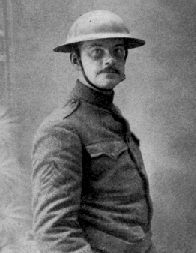
Sgt. Joyce Kilmer
42nd Division
KIA at River Ourcq |
|
[In late] July three American divisions, the 3rd, 28th and 42nd were in line there, side by side with [another], the 4th, in close support [and the 26th and 32nd preparing to deploy]...By August the Germans had taken up a position behind the Vesle and Aisne Rivers, where they held fast...On 5 August the entire front of the French Sixth Army was held by two American Corps...
The 4th Division now relieved the 42nd, and on August 6th ... the battle front stabilized on the line of the Vesle (our 4th and 32nd Divisions being in line). The 42nd had lost some 5,500 officers and men.
...Now eight American divisions (the 1st, 2nd, 3rd, 4th, 26th, 32nd, and 42nd) had been indispensable in the reduction of the Marne salient. We had lost over 30,000, but the results were commensurate--not only was the Marne salient [greatly] reduced, but the initiative had been gained by the Allies and was never to be lost--the value of the American soldier, which had first been demonstrated by the 1st and 2nd Divisions, had been verified by the conduct of six other divisions.
From the beginning the Commander-in-Chief had never varied from his determination to bring the American forces together. The German offensive, however, had interrupted the execution of this plan, forcing us to utilize all our efforts to the end that the war might not be lost. Now, however, the initiative had passed into the Allied hands and there appeared to be no good reason for longer delay. On the contrary, the Chateau-Thierry operations had involved such difficulties in the way of supply and the evacuation of sick and wounded (in all of which we were largely dependent upon the action of French staffs) that it was apparent that our troops must be assembled. A few divisions might be properly cared for when dispersed under foreign command, but our forces had increased to the point where it became imperative to begin assembling them. [Preparations began for the American led St. Mihiel Offensive and the AEF Divisions started shifting from the Marne to the Verdun sector. More action, however, was to follow in the Marne region.]
|
|
TWO FUTURE MARINE COMMANDANTS CAPTURE THE SPIRIT OF THE CORPS AND THE EXPERIENCE OF THE
SECOND BATTLE OF THE MARNE IN A LEGENDARY BATTLEFIELD MESSAGE:
From Co. "H"
At: ?
Date: July 19. Hour 10:45 am
To: Major [Thomas] Holcomb.
I am in an old abandoned French trench bordering on road leading out from your P.C. and 350 yds. from an old mill. I have only two men out of my company. We need support, but it is almost suicide to try and get here as we are swept by machine-gun fire and a constant barrage is on us. I have no one on my left and only a few on my right. I will hold.
[Clifton] Cates
2nd Lt. 96 Co.
|
The Oise-Aisne Offensive
August 18 - September 16, 1918

Gen. Charles Mangin
Commander French 10th Army
|
Click Here To See a Map of Where American Divisions Served
Throughout the Second Battle of the Marne
|
For a month, from the first week in August to early September, the Germans stalled the French and Americans on the Vesle lines. The Americans held roughly six kilometers from St. Thibaut to Fismes and bitterly fought the Germans in seesaw actions for the possession of bridge heads at Bazoches, Chateau du Diable, and Fismette...Afterwards Bullard commented: " I have rarely, if ever, seen troops under more trying conditions... they were on the spot and they stayed there..." Any movement by day brought down fire, as the Germans used cannon to snipe at careless soldiers. They were also lavish with mustard gas... Throughout most of the month in "Death Valley," a name the Pennsylvanians [28th Div.] gave the Vesle Front, the 28th Division under portly Charles H. Muir shared the sector with the 77th Division [made up] of draftees from New York City and its suburbs...
|
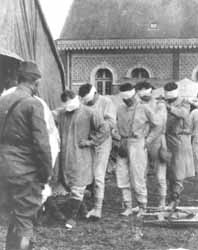
American Gas Victims
|
|
What finally broke the deadlock on the Vesle was an attack by the French Tenth Army north of Soissons in late August. Although understrength and not yet recovered from the rigors of their fighting on the Ourcq and Vesle lines, the 32nd Division took part in this operation. In fact their capture of Juvigny on August 30th was a crucial blow against the German Defenders.
|
 The 32nd Division Before Juvigny
|
The French used the nickname "Les Terribles" to praise this division's prowess in battle... Their battles of late July and early August had been hard, but the Juvigny fight was much tougher. The German Defenders fought hard and made effective use of the caves in the are to protect their machine guns but "Les Terribles" were stubborn in their determination to force the Germans back. They succeeded in capturing the ruins of the village of Juvigny and in advancing some two and a half miles in five days of constant battle. The division historian referred to this period as "five days of hell on earth."
...The Germans gave up the Vesle line only to fall back a few kilometers nearer the Aisne River where they again stabilized the front. They could be proud of their defensive actions since the collapse of their last offensive. The attack at Soissons had surprised them, but, after a couple of anxious days the German commanders had regained control of the situation. True, they had to give up the Marne salient, but they succeeded in withdrawing their forces to pre-planned phase lines on the Ourcq and the Vesle on schedule... Significantly, [however,] the German definition of success changed in July from how many kilometers they advanced to how well they conducted a retreat.
|

German Fatalities |
|
The results of the Aisne-Marne operation were far out of proportion to its size...the initiative [on the Western Front] had passed to Allied hands, where it would remain, and Ludendorff would be compelled to postpone indefinitely his cherished Flanders offensive. With German morale sagging, it was clear that Ludendorff's hope of crushing the Allies before the United States could put a large force in the filed would not be realized.
Even as the Second Battle of the Marne was winding down the AEF had begun its first major offensive as an independent force at St. Mihiel.
|
|
BY SUMMER OF 1918 MANY AMERICAN HOMES WERE STARTING TO RECEIVE LETTERS SUCH AS THIS:
Mrs. Ackerman -
Your husband, Sergeant Lloyd C. Ackerman, was in my company, and was the best sergeant I ever had. I thought a lot of him, and was greatly grieved when he was killed. He was right at my side when he was killed. We were in a wheat field about five miles northwest of Chateau-Thierry, and your husband is buried right there. Your husband died a hero. He was right in the front line advancing on the Germans, when some machine guns opened up on us and killed many of our men.
Sgt. Ackerman was the best drill sergeant I ever had, and was cool under fire. The company and regiment lost a very valuable man when he was killed, and I personally feel it very deeply. I cannot speak too highly of him...
Captain W.F. Marshall, 318th Inf., 4th Division
|
|
To find other Doughboy Features visit our
Directory Page
|
For Great War Society
Membership Information

Click on Icon |
For further information on the events of 1914-1918
visit the homepage of
The Great War Society
|
|
Sources and thanks: General material and Background: Includes quotes from THE MILITARY HISTORY OF AMERICAN by Dupuy & Dupuy, 1956, THE WAR TO END ALL WARS by E.M. Coffman, 1968, and miscellaneous connecting material by myself. Phase I is mostly quoted from THE GREAT ADVENTURE by Pierce Fredericks, 1960; the battle quote is from the JESSE WOOLRIDGE ARCHIVE, Hoover Institution; and the Ludendorff is from AS THEY SAW US by George Viereck. Phases II & III are primarily from NOTES ON CHATEAU THIERRY OPERATIONS by Brig. Gen. Fox Conner, G-3 [Operations] for the General Staff; Lt. Cates's famous message is on the USMC website and the letter to Mrs. Ackerman is on the website of the Vandenburgh County Indiana Gold Star Sons website which can be accessed on the Doughboy Center's Biographies and First Hand Accounts page. Photos are from Steve Collins, Joe Hourigan, Glenn Hyatt and Ray Metzger. If I've forgetten anyone, please contact me. MH
|
Additions and comments on these pages may be directed to:
Michael E. Hanlon
(medwardh@hotmail.com) regarding content,
or toMike Iavarone (mikei01@execpc.com)
regarding form and function.
Original artwork & copy; © 1998-2000, The
Great War Society
|



















